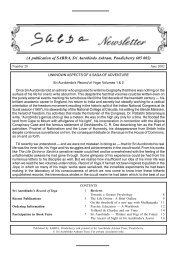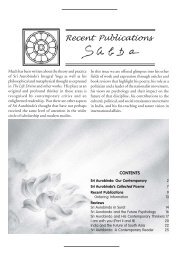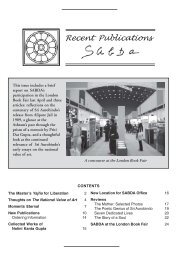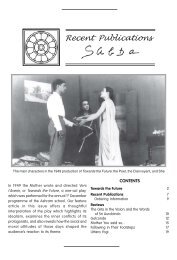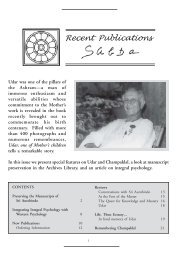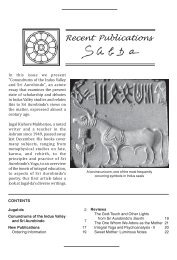Recent Publications - Sabda - Sri Aurobindo Ashram
Recent Publications - Sabda - Sri Aurobindo Ashram
Recent Publications - Sabda - Sri Aurobindo Ashram
Create successful ePaper yourself
Turn your PDF publications into a flip-book with our unique Google optimized e-Paper software.
22 <strong>Recent</strong> <strong>Publications</strong><br />
understanding of the materials presented. The<br />
psychological and spiritual significances escape the<br />
normal, uninitiated individual, but Shri Medhananda<br />
ferrets them out with consummate ease. The tales then<br />
cease to be mere stories but reveal themselves to be<br />
storehouses of spiritual knowledge and sempiternal<br />
wisdom. The astounding variety of myths and legends<br />
from the East and the West reinforce the fact that amid<br />
such cultural diversity inner truths are the same<br />
everywhere. I shall cull two accounts which have<br />
appealed to me very much: “The Gospel according to<br />
Thomas that was buried in the sand” [page 93] and “The<br />
Birth of the Golden Child” [page 125].<br />
Shri Medhananda’s treatment of these two themes, the<br />
former Christian and the latter pagan, is at once original<br />
and illuminating, highlighting his quest for that single<br />
truth, the one truth expressed differently in different<br />
times, climes, and cultures: ekam<br />
sat, viprDh bahuda vadanti (the<br />
truth is one; wise men express it in<br />
various ways).<br />
The plethora of Christian sects<br />
such as the Orthodox Church, the<br />
Roman Catholic Church, the<br />
Protestant churches, and various<br />
other denominations bear ample evidence of the fact<br />
that Jesus Christ, the mystic, yogi, seer, and avatar of<br />
Love, has been more misunderstood than otherwise.<br />
The mystics do not speak a simple, direct language.<br />
They use symbols, parables, and even paradoxes to<br />
express the holistic truth they experience, which cannot<br />
be expressed in trenchant mental terms. Many Gospels<br />
purporting to be the authentic recordings of Jesus’<br />
sayings have only added to the divisions in Christianity<br />
and the real meaning of Jesus’ utterances has taken a<br />
back seat. Shri Medhananda asserts that the Gospel<br />
according to Saint Thomas is one of the most authentic<br />
Gospels although it is “officially regarded as<br />
‘apocryphal’, unauthentic, not admitted to the New<br />
Testament canon”. He has made a significant selection<br />
of those logia (something like epigrams) which, with<br />
his interpretations, indisputably establish Jesus as the<br />
harbinger of the unity of Man, Nature, and God “who<br />
is all and in all”, which the Semitic people, blindfolded<br />
by a dualistic religion, could neither comprehend nor<br />
digest. Some quotations from the Gospel according to<br />
Saint Thomas are presented here:<br />
“Know thyself.” [Log 3]<br />
“If you are one and undivided you will be filled with<br />
light but if you divide (yourself) you will be filled with<br />
darkness.” [Log 61]<br />
“Whoever drinks my words from me shall become as I<br />
am and I myself will become he and that which is hidden<br />
will be revealed.” [Log 108]<br />
“Cleave a piece of wood, I am there: lift up the stone<br />
and you will find Me.” [Log 77]<br />
This particular log reminds us of the bhakta Prahlad<br />
who, when challenged by his tyrant father Hiranya to<br />
show his Vishnu, said ecstatically that the Lord Vishnu<br />
was in everything, in the dust as also in the pillar in<br />
front of him, meaning that he was all-pervading. This<br />
state of immanence, a<br />
pantheistic truth, is<br />
clearly evident in what<br />
Jesus said, though he<br />
“emphasises that He<br />
does not make this<br />
claim for himself alone,<br />
exclusively, as the<br />
church wants us to<br />
believe, but for everyone”. There is no gainsaying the<br />
fact that Shri Medhananda’s selection of Saint Thomas’<br />
Gospel has been done with impeccable insight and<br />
excellent judgement.<br />
Medhananda’s interpretations indisputably<br />
establish Jesus as the harbinger of the unity of<br />
Man, Nature, and God “who is all and in all”, which<br />
the Semitic people, blindfolded by a dualistic<br />
religion, could neither comprehend nor digest.<br />
The second narration is that of “The Birth of the Golden<br />
Child”, the birth of Hatshepsut, who became the<br />
celebrated Queen of Egypt and the builder of the famous<br />
temple at Deir-el-Bahri. The Mother once indicated<br />
that she had been Hatshepsut in one of her previous<br />
incarnations. At another time she also made a<br />
remarkable revelation that her body was specially<br />
shaped in her mother’s womb and it was presided over<br />
by Mahasaraswati herself. In the account that Shri<br />
Medhananda gives, with symbolic pictures, of the birth<br />
of Hatshepsut one can see a remarkable parallel to the<br />
Mother’s own birth. Hatshepsut’s body was shaped by<br />
the high gods of Egypt and she was born embodying<br />
the divine consciousness, a golden child.<br />
The apotheosis of Heracles or Hercules, as he is<br />
popularly known, is another theme that, under the<br />
scrutiny of Shri Medhananda, yields very rich insights



